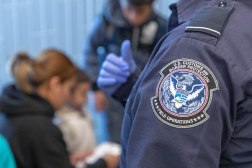CBP seeks info on body-worn cameras for use by Border Patrol

U.S. Customs and Border Protection is soliciting information on body-worn cameras and an attendant video management system to create an “Incident Driven Video Recording System.”
CBP also wants to know whether facial recognition and facial comparison technology is available to be run on these cameras.
The agency’s request for information (RFI) indicates an interest in the full lifecycle of the video process — from the actual cameras used to capture video, to the video management system where it can be redacted, tagged and searched as necessary, to the cloud storage where it can be stored.
CBP envisions the body cams being used by Border Patrol agents in service of their two-fold mission — detecting and apprehending illegal aliens and detecting illegal narcotics. The cameras would be part of a “targeted deployment” to “known interdiction points” where fixed cameras can’t capture interactions between Border Patrol agents and the public. The RFI says footage must be encrypted, high-definition and offloadable with “limited user effort.”
The RFI also includes a couple “features of potential interest,” and this is where facial recognition comes in. “Is this capability currently available?” the RFI asks. “If currently under development, when will it be operational? If applicable, explain why the vendor has decided not to offer the feature at this time.”
One company has already publicly answered this question — in July the leading body camera company Axon announced that it would not enable facial recognition on its devices. This announcement followed a review by the company’s independent ethics board, where the board concluded that “face recognition technology is not currently reliable enough to ethically justify its use.”
While the facial recognition component in this particular RFI is only a nice-to-have, CBP has previously stated that it envisions a world where the biometric technology is used for “all passenger applications.”
“The paradigm will evolve from biographic data focused to biometric data centric,” the agency wrote in a draft RFQ from this summer. “CBP will identify travelers biometrically based on information already in CBP holdings as an alternative to having the traveler present their travel document.”
The agency is already using facial recognition, in keeping with an existing legislative mandate, to verify the identities of departing international travelers through its Biometric Exit Program. But the technology is somewhat controversial, too — lawmakers and civil liberties groups have questioned its use.
CBP began a six month test of this Incident Driven Video Recording System in May 2018. The goal of that pilot was to “determine CBP’s capability needs and gaps with documenting incidents and to enhance transparency of operations through the use of fixed, vehicle mounted, and body-worn cameras, while supporting officer safety.” Now, it seems, the agency is moving forward.
Responses to the RFI are due by Oct. 31.






